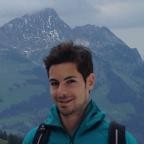EESS talk on "Physics and modeling of wind-blown sand and snow"

Event details
| Date | 27.09.2016 |
| Hour | 12:15 › 13:15 |
| Speaker | Mr Francesco Comola, CRYOS |
| Location | |
| Category | Conferences - Seminars |
Abstract: The aeolian transport of granular materials, such as sand and snow, is responsible for a wide range of environmental effects. Drifting sand forms dunes and ripples, erodes geological features, generates dust emission and provides a limited amount of nutrients to several ecosystems. Drifting snow, on the other hand, controls mass and energy budgets of polar and alpine regions, with relevant impacts on sea level rise, avalanche triggering, and water resources management. Here, we provide a better insight into the physics of sediment transport by investigating two fundamental surface processes, namely particle ejection and particle fragmentation. Impact-ejection dynamics, the so-called splash entrainment, is modeled through a stochastic ejection function derived from energy and momentum conservation laws. Our analysis suggests the ejection regime of saltating snow is strongly controlled by cohesion and that the anti-correlation between mass and velocity of ejected grains significantly increases the average number of ejecta. We review recent advances in the field of dust aggregate fragmentation and propose a new fragmentation theory for fractal snow crystals during wind-driven saltation. Our theoretical framework successfully explains the typical features of blowing-snow size distributions, i.e. the emergence of a self-similar scaling for large diameters and the deviation from the power-law distribution for small diameters. Finally, we account for the improved understanding of surface processes in a sediment transport model based on Large Eddy Simulations and Lagrangian-stochastic particle tracking. An Immersed Boundary Method is also adopted to effectively reproduce the surface drag exerted by complex terrains. The comprehensive modeling approach proves a solid base for studies of aeolian transport in arid and polar regions, as well as on other planets.
Short biography: Francesco Comola received his B.Sc. and M.Sc. degrees in Civil Engineering at University of Padova, Italy. His master project in hydraulics was carried out at Aalborg University, Denmark, with the support of an Erasmus scholarship. He is currently Ph.D. student in the CRYOS Lab. at EPFL. His research focuses on transport phenomena in snow-covered environments. He seeks to cast complex transport processes in statistical-mechanics frameworks, which he employed to model temperature dynamics in alpine streams and wind-driven transport of snow in polar regions. He was recently granted the EDCE mobility scholarship to conduct research on fragmentation of wind-blown snow crystals at the University of California, Los Angeles.
Short biography: Francesco Comola received his B.Sc. and M.Sc. degrees in Civil Engineering at University of Padova, Italy. His master project in hydraulics was carried out at Aalborg University, Denmark, with the support of an Erasmus scholarship. He is currently Ph.D. student in the CRYOS Lab. at EPFL. His research focuses on transport phenomena in snow-covered environments. He seeks to cast complex transport processes in statistical-mechanics frameworks, which he employed to model temperature dynamics in alpine streams and wind-driven transport of snow in polar regions. He was recently granted the EDCE mobility scholarship to conduct research on fragmentation of wind-blown snow crystals at the University of California, Los Angeles.
Practical information
- General public
- Free
- This event is internal
Organizer
- EESS - IIE
Contact
- Prof. Michael Lehning, CRYOS-EPFL and SLF Davos